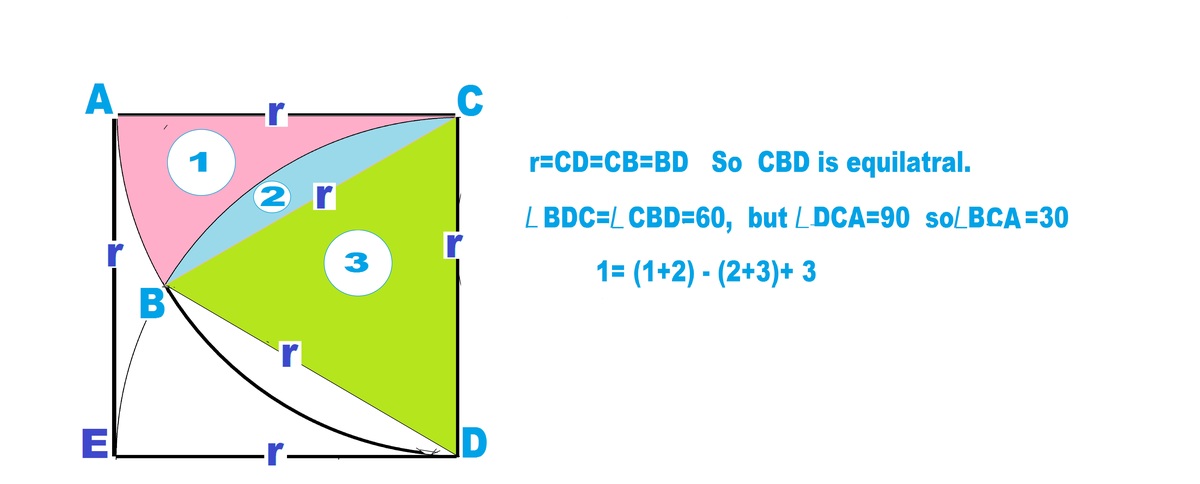Polka Dots in Pi
In the figure, A B C D is a square of side length a units and E , F , G , H are the midpoints of the sides.
E A H , F B E , G C F , H D G are quadrants. There are two semicicles with diameters A D and B C .
If the area of the shaded region in red can be expressed in the form
x a 2 ( y − z π )
then submit z x y as your answer.
The answer is 4.
This section requires Javascript.
You are seeing this because something didn't load right. We suggest you, (a) try
refreshing the page, (b) enabling javascript if it is disabled on your browser and,
finally, (c)
loading the
non-javascript version of this page
. We're sorry about the hassle.
2 solutions
Exactly Same Way.
What a lovely solution

Consider one fourth of the square as shown in the sketch. It is a square with sides a = 2r. The quarter circles ABD and CBE are with radii r. ∴ r = C D = C B = B D . ⟹ C B D i s a n e q u v i l a t e r a l Δ . ⟹ ∠ B D C = ∠ D C B = 6 0 , b u t ∠ D C A = 9 0 , ∴ ∠ B C A = 3 0 . Areas 1=(1+2) - (2+3) + 3 A r e a 1 + 2 = 3 6 0 π ∗ r 2 ∗ 3 0 , A r e a 2 + 3 = 3 6 0 π ∗ r 2 ∗ 6 0 , A r e a 3 = 4 3 ∗ r 2 . ∴ A r e a 1 = 3 6 0 π ∗ r 2 ∗ 3 0 − 3 6 0 π ∗ r 2 ∗ 6 0 + 4 3 ∗ r 2 = 4 3 ∗ r 2 − 3 6 0 π ∗ r 2 ∗ 3 0 . T o t a l R e d a r e a f r o m g i v e n d i a g r a m = 4 ∗ { 4 3 ∗ ( 2 a ) 2 − 1 2 π ∗ ( 2 a ) 2 . } 4 a 2 ∗ ( 3 − 3 π ) , 3 4 ∗ 3 = 4
Area of Yellow region,
= 6 1 ⋅ 4 π a 2 − 2 1 ⋅ sin 6 0 ∘ ⋅ 4 a 2 = 8 a 2 ( 3 π − 2 3 )
Area of 1 red region = Sector PHQ - 2 Yellow regions.
= 6 1 ⋅ 4 π a 2 − 2 ( 8 a 2 ( 3 π − 2 3 ) ) = 2 4 1 π a 2 − 1 2 1 π a 2 + 8 3 a 2 = 8 3 − 2 4 1 π a 2 = 8 a 2 ( 3 − 3 π )
So the total red area,
= 2 ⋅ 8 a 2 ( 3 − 3 π ) = 4 a 2 ( 3 − 3 π ) ⇒ 3 4 ⋅ 3 = 4